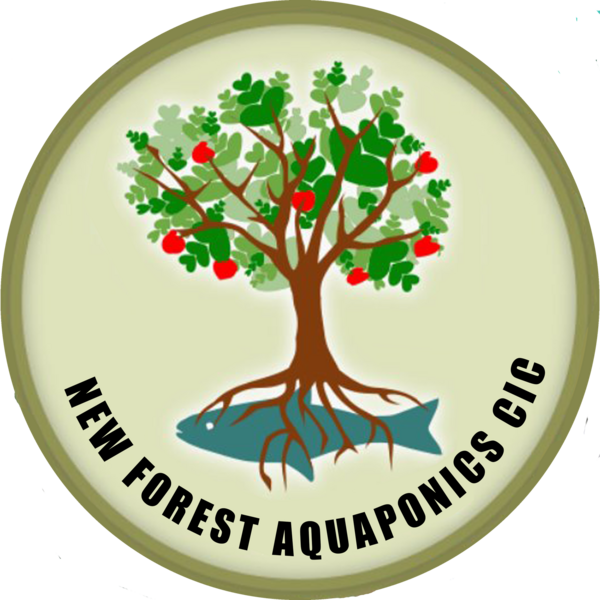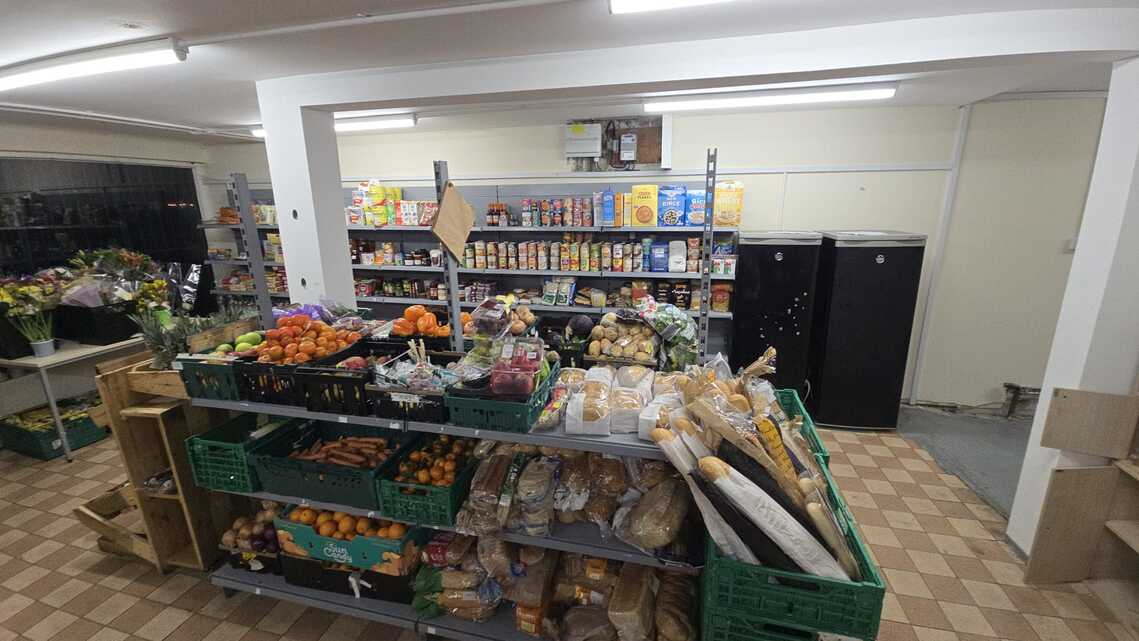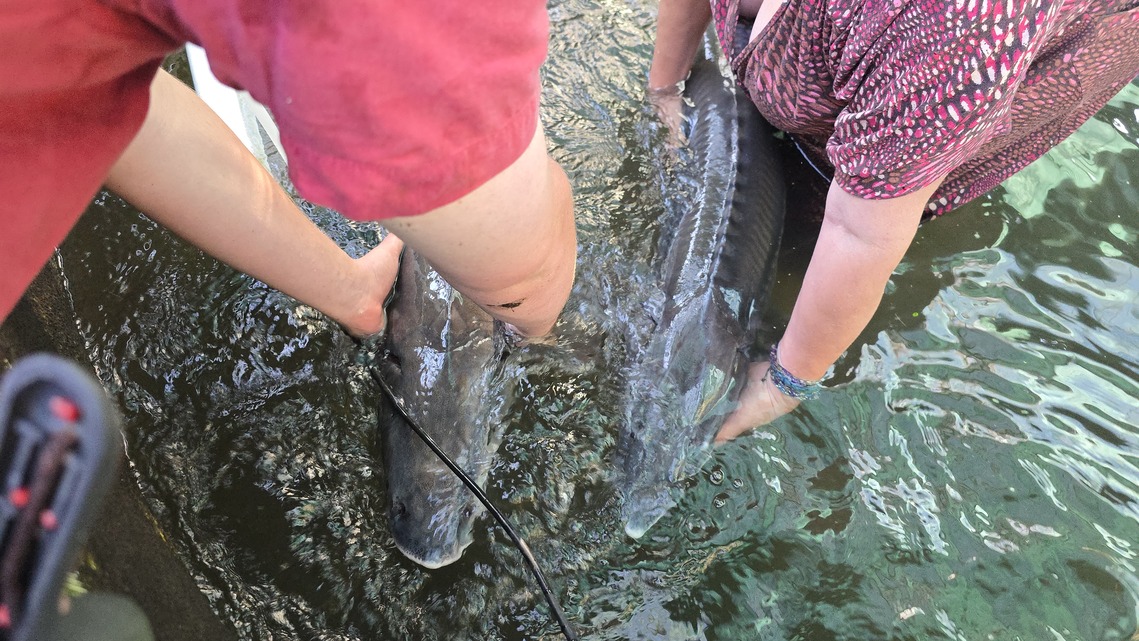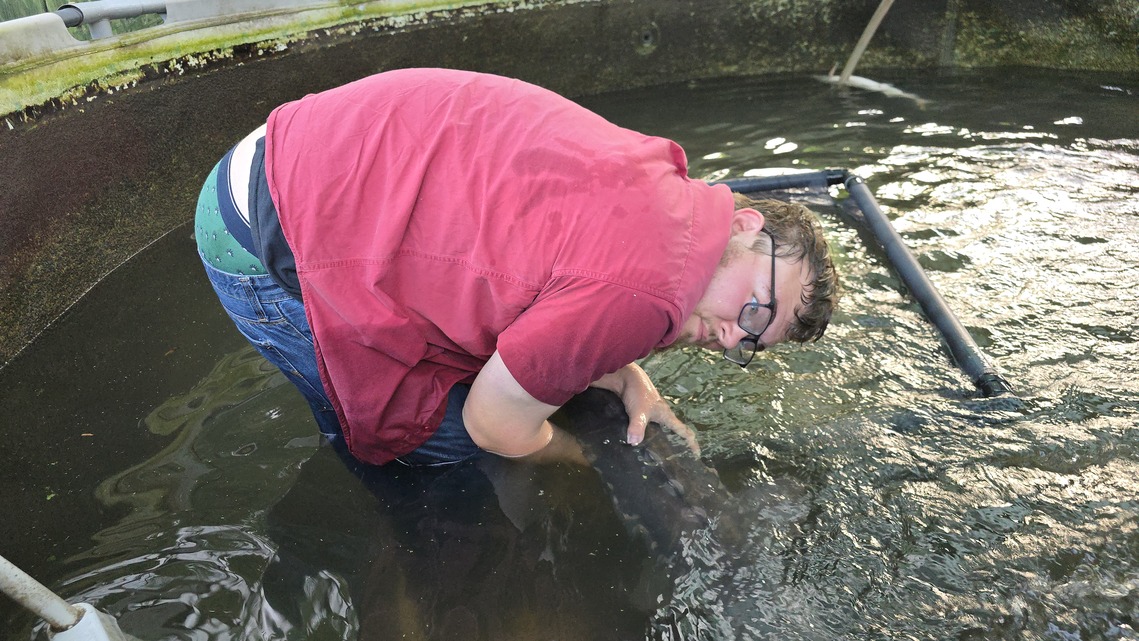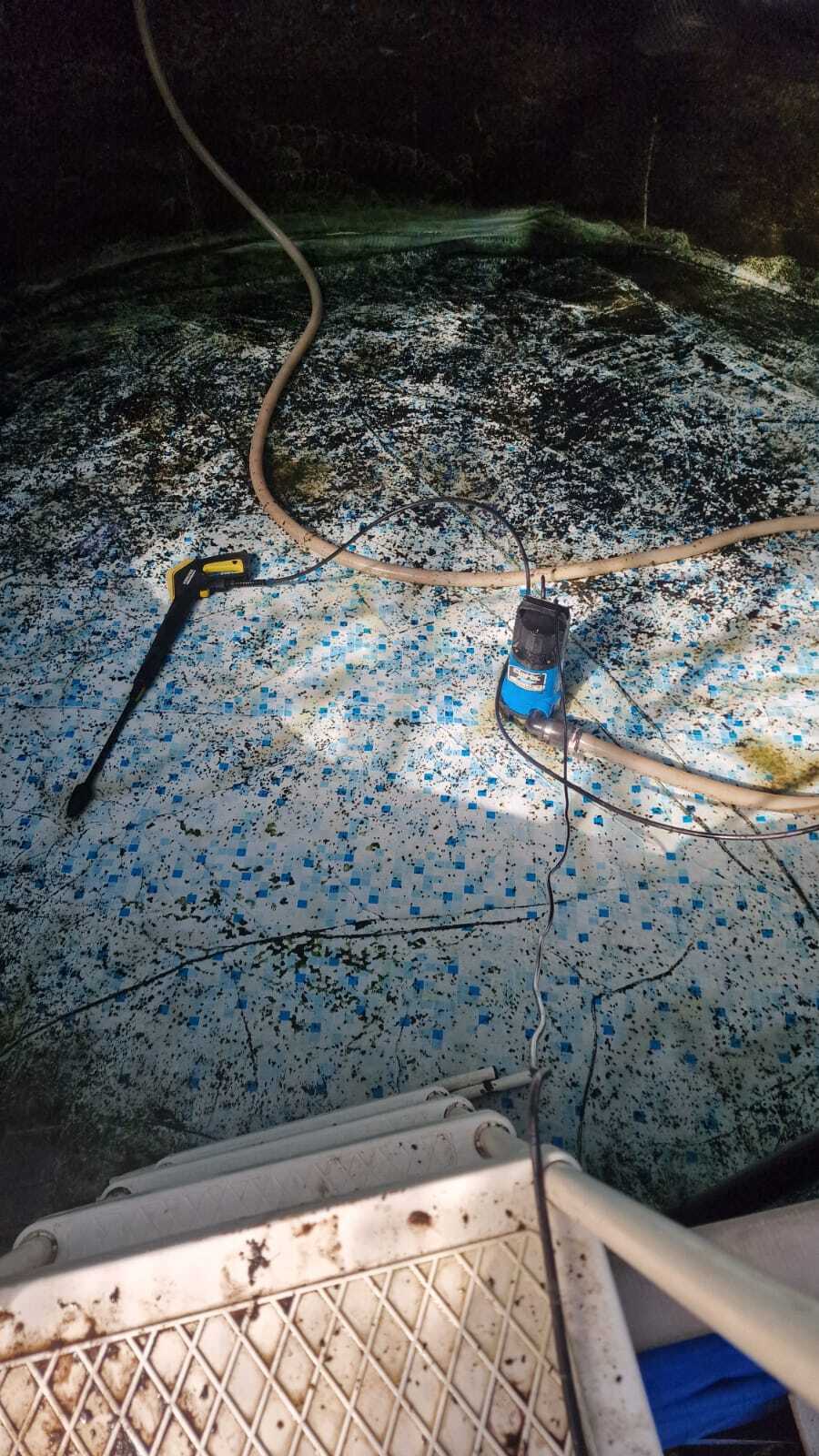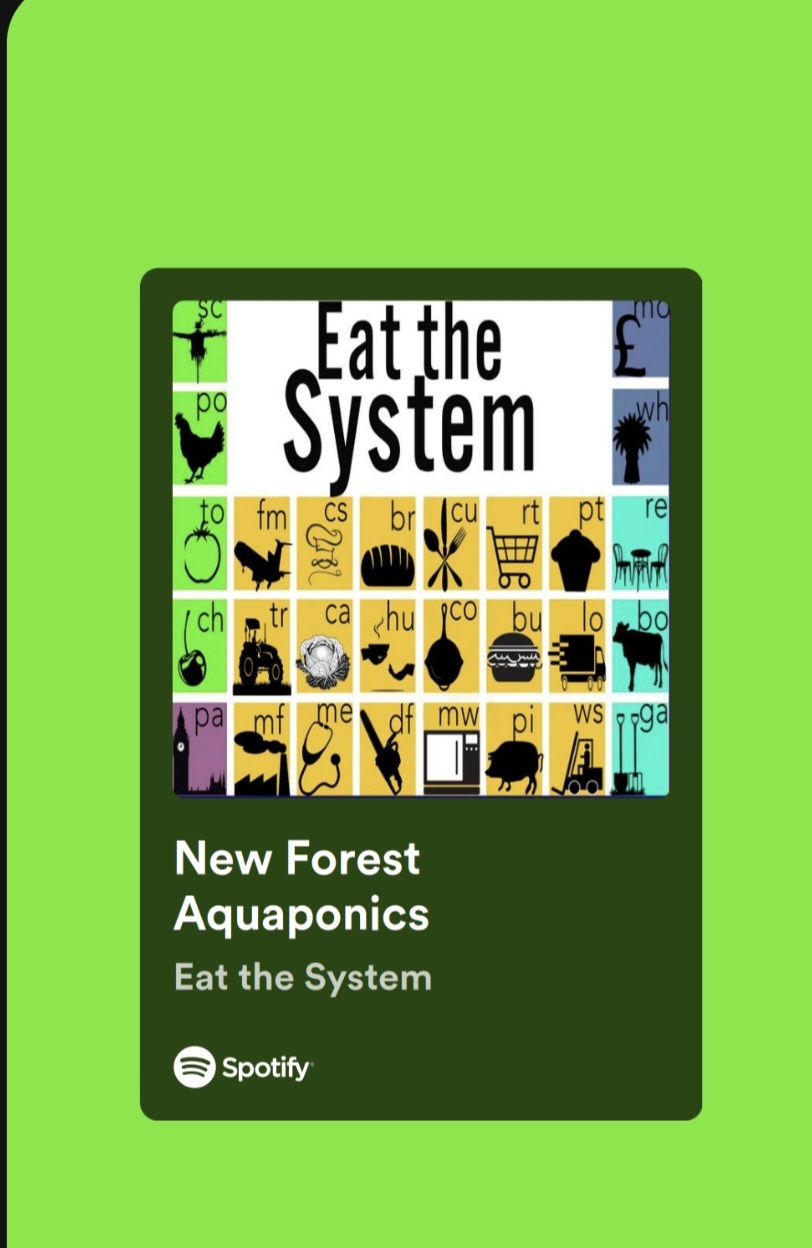Blackfield Pantry
What is it about and where has it come from
The Waterside Food Project has been going for over 3 years, and is run by New Forest Aquaponics CIC.
In 2018 we wrote out our vision for our non profit community interest company (CIC) with our aquaponic farm at the centre, it included everything we wanted to see in our local community and accessible to all. We were aiming for a demonstrable vision for living modern lives that are kind to our earth and all who live with it.
The fish in the aquaponics farm need to be fed, and as we dont want to be taking fish from the sea to feed our fish, we needed to feed them in another way. This means producing our own fish food, which involves growing insects, such as black soldier flies (BSF) for the pupae to feed the fish as a protein source. BSF feed on food waste, so I searched for how I would be able to collect food waste in volume. My search was answered by a friend Rosie Brent, who was collecting food from M & S once a week for the flowers for her work. As she didn't need the food, after handing it to her friends and neighbours she gave us the rest, it was all perfectly good edible food, not the waste we were expecting.
It needed eating by people! At first we would walk round our neighbours asking if they would like any of this food as it was only once a week. We then meet Dawn Cullen and her Waste not want not project running pop up food shares across the waterside.
This led to us working together for a while collecting and sharing food.
The volume of bread quickly became a problem, the shops just produce so much of it. We found a farmer with cows who would take what was left of the bread. Cow bread is now very much part of our weekly routine, it is sadly junk food for cows.
One day two boys were seen taking the cow bead that was waiting to be loaded in the car and eating it as though they were really hungry. We knew we needed to do more.
Within hours one of our neighbours produced our very first box, and this allowed us to leave food out for people to take as they walked past the house. It proved very popular, and helped us see how much need for community action was out there.
This led us to start the Waterside Food Project gaining our own collection slots and working towards opening the community fridge - which was my first lesson in how long things can take and just how hard they can be!
Both food projects in the waterside although working in very different ways still help and support each other to maximise the number of people we reach.
Then came our blue box - which is an old giant cool box from the cruise ships, they changed how they move food around and gave the boxes away. It works amazingly well and keeps the food super cold without anything more needed than an ice pack in summer.
As the community fridge opened in Hythe library we wanted to make it easier to share some of the bulk produce we were getting, by cooking ready meals to go in the freezer. But we needed a kitchen to use.
Blackfield Baptist church came to the rescue and have been amazing at supporting our work and helping us with one of the most important elements for us - building community.
We've only ever managed to get a few ready meals made as the first week we cooked, Dave Green who is our chief said - go see if anyone would like to eat a hot meal with us. Five people joined us that week, now we serve up to 40 people for a sit down meal and 15 takeaways every week.
The meals are for everyone to come and socialize, are completely free ( although donations are greatly received), and are all made with the supermarket surplus foods. There is also a table of bread and veg for people to come and collect.
I was quite happy with all of this, but none of it really addressed the issues I was seeing in the food system, and the number of people affected by its unfairness. By this time I had done a course with the Soil Association called My Food Community and a course by the Landworkers Alliance - New Entrants Support Scheme, both looking at the UKs’ broken food system, one from the farmers perspective and one from the food system change maker's perspective. This showed me we needed to do more, we needed to make healthy food more accessible for the people of the Waterside, after all it is a basic human need.
It had been suggested to me we were in the right position to look at opening a community pantry, but it felt too big a task, after all we didnt have a building to use. We put the idea on a back burner, and got on with working on moving our aquaponics farm to its new home.
Then one of the independent shops in Blackfield had to close due to the owners ill health and the lease was to become available, all we needed was some funding.
Thankfully the funding from Hampshire County Council Household support fund for setting up a community pantry was available and we were very grateful to be awarded enough money to take on a 10 year lease of the building and running costs for 6 months. This process was my second lesson on just how long everything takes, and how frustrating our systems are!
A new member of our core team Debbie Whitcombe, who has a long career in community projects has joined us. You will see her at the pantry keeping everything ( and me ) in order, and we would have not got the funding without her help.
The building itself was built in 1933 and was originally a butcher shop, and as such it has been built to be cold! We are working on making it warmer. Through its life more and more parts to the building have been added to make it the huge space it is now. This means as well as a community pantry it can be a home to community projects and a meeting place for groups.
On Sunday the 12th we held a community engagement day with the help of Culture in Common, Seekers Create, and Serious Lego.
Thank you to all who came along and gave us your input to what you would like us to do with the rest of the building. We are in the process of assessing all of your ideas and working towards making as many of them as possible a reality.
But how will we make this work in the long term? Funding cannot be relied upon, and we have rent and bills to pay for, and this is where you come in. We are asking everyone who would like to use our community pantry and community space to take out a yearly membership of £10 per year. This will help us pay the rent and ensure the pantry and community space thrives. And even if you don't live in the area but love what we are doing and want to support us you can take out membership, everyone is welcome.
The idea is for the community to support the community, the pantry cannot work without a place to run from, and by having the building other people can benefit from a social space.
Can the waterside community demonstrate that this model of community supported supermarkets can work? Making healthy food affordable and where possible free for all?
I haven't been able to find a similar project in the UK that combines all the different aspects we have pulled together. There are some in the USA and a few in Europe, but would love to hear of any you have come across.
Blackfield Community Pantry is open to everyone within the community, we are not a food bank, and do not do crisis work, but if you are finding it difficult financially we hope that the community pantry will help . Membership is open to anyone from any background or income to help take financial pressure off you and allow for you to focus on other areas of your lives that otherwise would be difficult being stabilised.
We hope you will be able to make friends, new connections, learn new skills all while shopping in a way that allows you to support your family with healthier affordable food.
Pantry Details
£10 per year membership
£7.50 for up to 15 items from the outside shelves.
Bread , fruit and veg in the middle isle are free
One shop per week.
We are working towards being open 3 days a week, but building this slowly while we and our volunteers learn how to run the pantry.
Tags:
The pain of sturgeon farming or what can go wrong on an aquaponics farm in the UK
A request for help
This is an account of what went wrong the other week, I truly hope this never happens again, but your help is needed to ensure that.
Swimming pools for fish farming?
We use second hand swimming pools for the fish and on the whole they work really well. They are a super cheap option, and having no money, being able to pick one up for as little as £50 is a real bonus.
We have a duty to keep our fish in the best way possible and a 15 foot swimming pool allows for a large volume of water to be held for the fish. Wherever possible we try to use second-hand equipment so we can keep our impact on this beautiful planet of ours to an absolute minimum, and for a long while these have worked, and for many of the fish, we keep they still do work.
The great thing about swimming pools is that they are round, allowing the fish to swim without stopping, rivers don't have corners, so fish find them hard to cope with. Creating a natural swimming pattern is important for fish welfare. Secondly, they hold a large volume of water for very little cost. Our 15 foot pools hold around 3000 gallons. This allows us to hold a lot of fish by the time you add on another 2000 gallons held in the filtration system, plant trays and sump. And there are many 2nd hand pools available each year, I am always shocked at how many people purchase a new one every couple of years.
Now the down side. They don't cope with big fish.
Our sturgeon are growing fast which is amazing, quicker than we thought they would according to growth data we have been able to access. But that means they are close to outgrowing the ponds but also if they decide that they're going to splash about ( which they do quite often) they can do things like one of them did.
On the Monday I got a call from Dave in the middle of the afternoon when he got to the greenhouse to say get to get there quickly. The sturgeon were belly up, and the pond had split.
Those are words that fill me with dread, because belly up usually means dead and sturgeon are at the heart of everything we do.
As we only have one car at the moment I got our neighbour to drive us to the greenhouse. Myself, James, Robbie and Lucy, Robbie's girlfriend, all jumped in her car. James was able to grab towels and clothes for Dave, sadly not for anyone else though, and we headed up there as quickly as we could.
When we got there David was a little bit calmer as there were only a few of the fish that he hadn't been able to bring around already. The pond was still holding enough water for the fish to cope with and he was topping it up at roughly the same rate it was leaking. He had been able to pump pure oxygen from our oxygen cylinder into the water which had brought most of the sturgeon round straight away, they are very oxygen sensitive. This was necessary because as the water had dropped from the hole that had appeared in the pool the oxygen levels had dropped to a level that the sturgeon could not cope with. It is the one thing that affects them, sturgeon are really tough strong fish but if the oxygen level drops you have roughly two hours to rectify everything to save them, thankfully he had arrived in time. Although the water was still slowly slowly dropping it was a slow enough leak that we could buy ourselves time by adding fresh water. With the added pure oxygen, extra water pumps moving the water around to increase oxygen levels and extra air pumps in the pond plus increased water level most of the fish had come around on their own very quickly, and were out of danger.
That just left 10 that we were very worried about.
The trick to helping sturgeon recover from oxygen depletion is to hold them directly over fast flowing water which is rich in oxygen. Holding them like this so the water is going through their gills is a little bit like putting an oxygen mask on a person.
David had been standing in the pond tending to those that were affected directly over water sources, but we needed him to start taking other action to work out where we were going to put the fish because the pond obviously needed fixing urgently. So Robbie and I jumped in the pond and took over fish holding duties. The water was very cold. We try to keep it as cool as possible for the sturgeon as that keeps the oxygen levels high and more like the natural temperatures they would live in. Whilst we worked with the fish Dave got a second pond ready for the smaller sturgeon and then started moving the largest sturgeon into the other 15-foot pool.
All in all Robbie and I stood in that pond for four hours trying to nurse those fish back to life.
Robbie in the pool.
We saved two of the ten who were struggling and of the 60 sturgeon we could have lost this was not as bad as it could have been, although every fish lost is damaging to our work and of course the fish. Every single sturgeon is so precious and hurts us if we lose any of them.
They are not just fish to us they are our life's work for and as most of the species are on the critically endangered list or endangered in the wild every fish is really important. There are very large scale farms across the world who keep hybrids or only keep one or two species we have always prided ourselves in trying to have a diverse collection of sturgeon not just because we wish to produce caviar at some point but because we believe in being able to breed these sturgeon to keep the populations diverse around the world.
It turned out once Dave headed back to the greenhouse the next day and the water was all out of the pond, that one of the sturgeon had poked his nose through the side of the pond. It must if been spooked by something, sometimes there's a loud noise outside or something that would disturb them and they swim really fast and bash against the side of the pond. As you can see from the picture there is a nose shaped hole in the side of the pond. One of the things that really helped stop the pond completely splitting and all of the water coming really fast is that we double skin the swimming pools having had one that a few years ago did completely split! We now never take that chance and always have two liners sitting around each other. This means that only one is ever going to split at any one time and it gives us plenty of time as in this instance to save the fish.
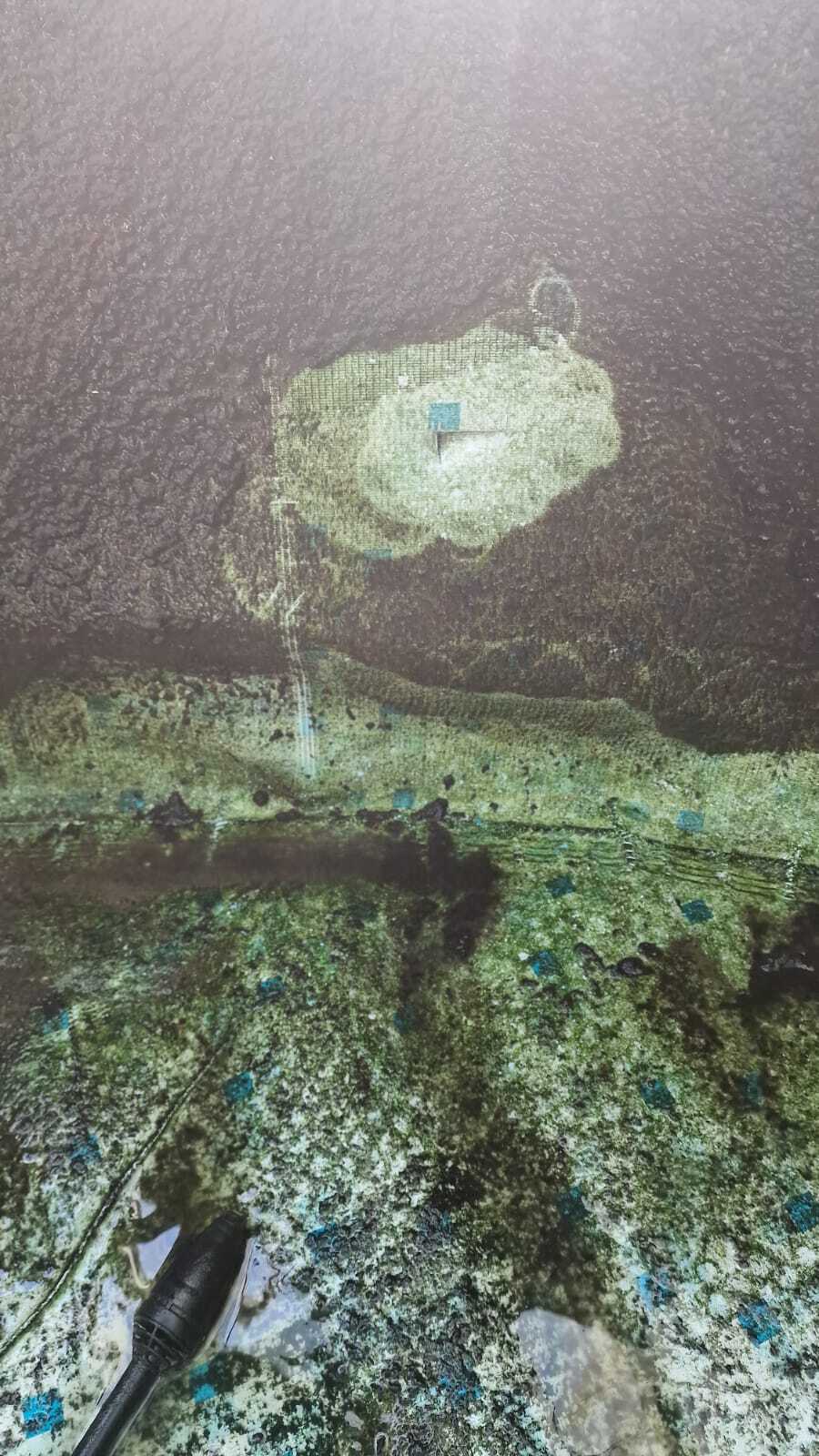
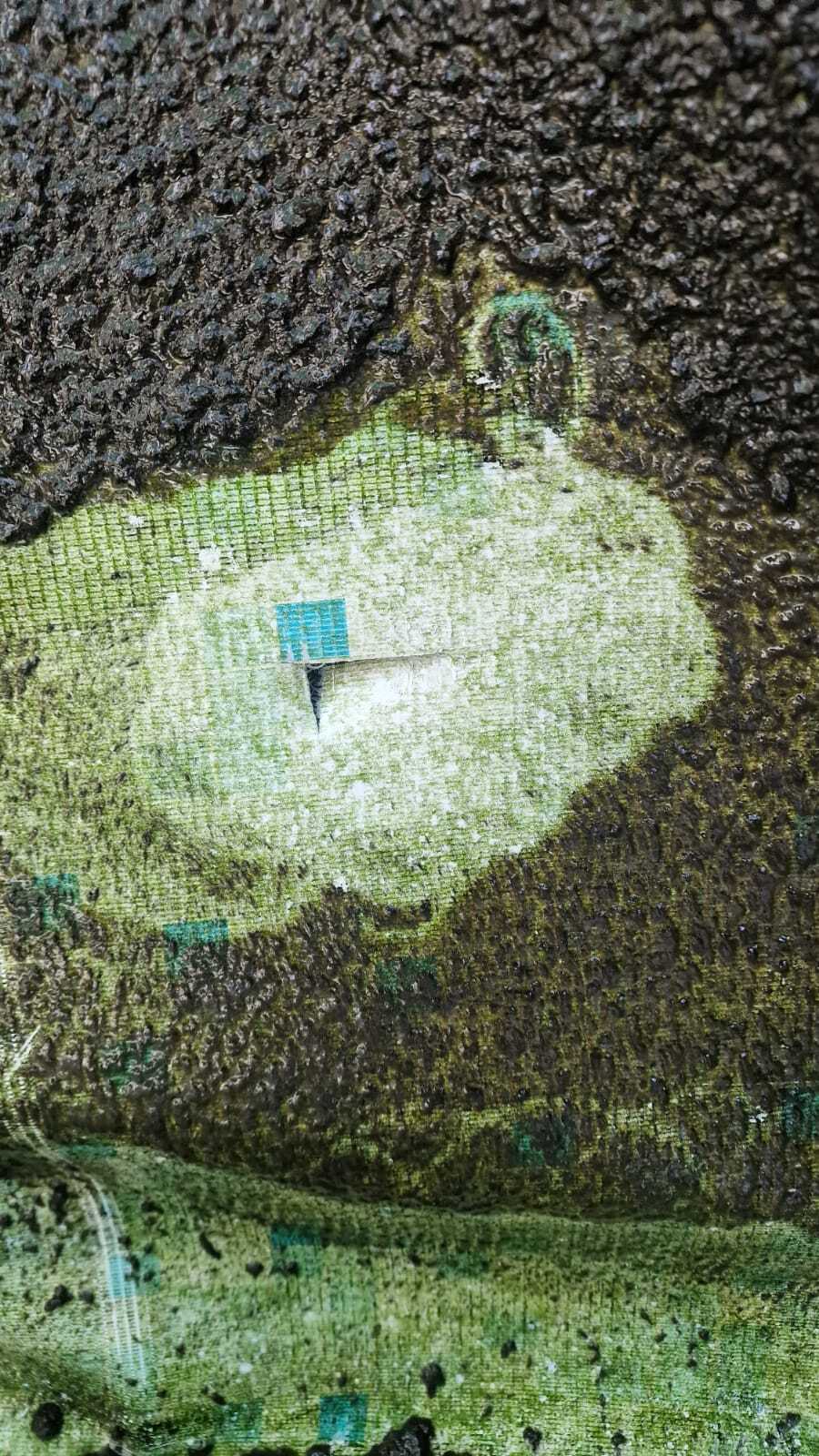
Pressure washing to find the hole - The hole! - Always a shame to remove he life on the sides of the pond that help make it a living system.
As we believe passionately that nothing should go to waste we have skinned the surgeon that we have lost and the skins will be tanned to create leather when we have a bit more time. The bodies we have composted, and have already completely broken down in our hot composting bays. It did give us a really good opportunity to check whether we had worked out the sexes of the fish right. Of the eight two were too young to tell, two we got completely wrong and the other four we had got right. Sadly one of the females had a belly full of eggs which weren't quite mature enough to actually be caviar. We believe this is why she didn't survive because of her extra body mass from the eggs, she struggled with the lower oxygen levels quicker and sooner and for longer than some of the others.
Dave’s patched the pond, a career of 35 years in pond maintenance and building means he is very good at repairing ponds so they are safe. And it's almost at the time of writing it's almost ready to have the fish put back in but really need to stop using swimming pools especially for the sturgeon.
We've been drawing up the plans for the system at our new site at Boldre and we have spaced it all out so that there is room for 20 ft metal sided ponds lined with butyl pond liner. This is the most secure way to keep these fish. The ponds will be round and they work beautifully in fact they are used around the world for fish farming.
Downside is that they are around £3000 each and we don't have a penny to rub together! Everything we do is on a shoestring but now I really do need some help to actually achieve keeping our beautiful amazing fish safe.
If you would like to help us there is a donation link at the bottom of this article you can also find it on our home page with more details. Even if the moment we can only get one pond to house the biggest surgeon we would be intensely grateful and it's the key to us progressing with our regenerative aquaponics farm. It is time for us to prove everything we've been saying over the last few years, that aquaponics does work on a community level and can provide a planet friendly addition to farming in the UK.
Tags:
Eat the System Podcast
Our chat with Darren Squires
During the last 3 months of 2023 I took part in the My Food Community course run by the Soil Association. The aim of the course is to bring together people who are involved with food systems in the UK to look at how things can be changed to make the landscape of food more sustainable and fair in the UK.
I was really privileged to take part, I felt the course was very much above my pay grade ( I don't get paid for my work with the waterside food project) and the other participants all seemed to work for big charities, or food partnerships or councils.
One of the connections I made was Darren Squires who produces the Eat the System podcast. It looks at all aspects of the UK food systems, listening to his back episodes has been really interesting.
I was very honoured when he asked if he could interview David and myself about our work with New Forest Aquaponics CIC.
So here it is our first joint podcast interview!
I think it explains quite well what we are doing and how we are doing it.
A huge thank you to Darren for asking us and his excellent editing skills, and to Rob Green for helping with the sound tech at our end.
I hope you enjoy and would love to know what ypu think.
https://open.spotify.com/episode/6PlKuFCj5ld5FC70hwDc0P?si=FlNoa3tPTxSmK78EFal-1A
It is available on all platforms just search for Eat the System
and please share!
Tags:
Archive
Use the calendar or list of months to view entries made on those dates.
| S | M | T | W | T | F | S |
|---|---|---|---|---|---|---|
| 1 | 2 | 3 | 4 | 5 | 6 | |
| 7 | 8 | 9 | 10 | 11 | 12 | 13 |
| 14 | 15 | 16 | 17 | 18 | 19 | 20 |
| 21 | 22 | 23 | 24 | 25 | 26 | 27 |
| 28 | 29 | 30 | 31 |
